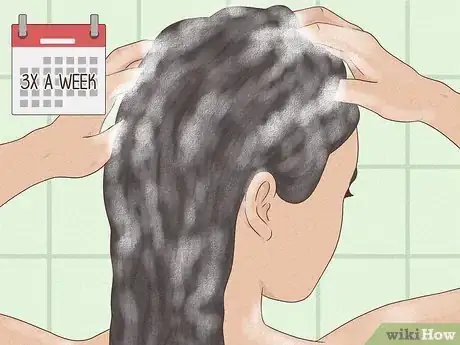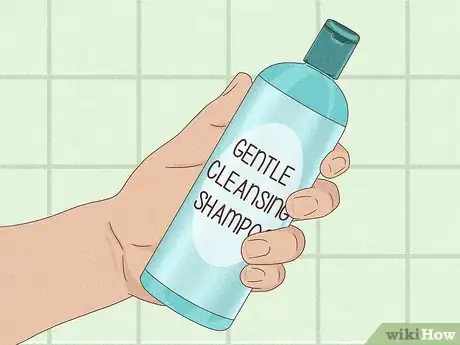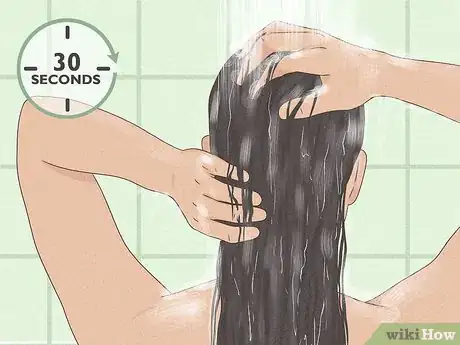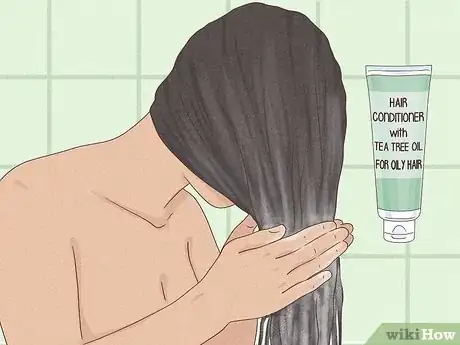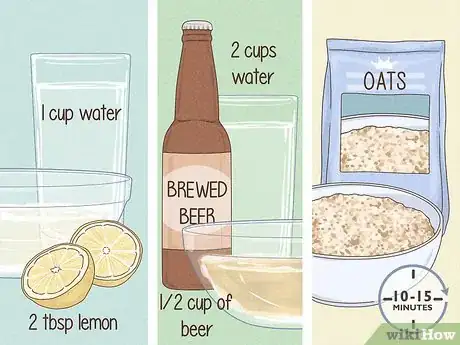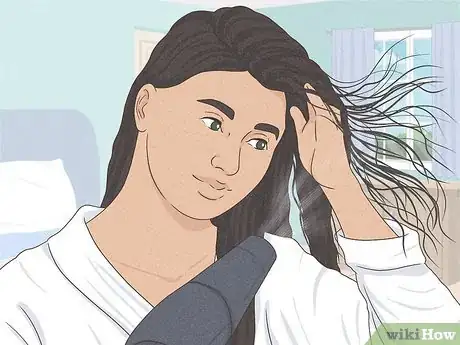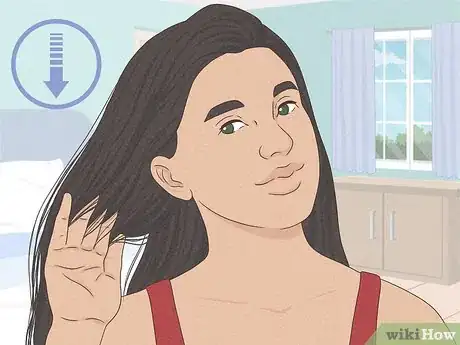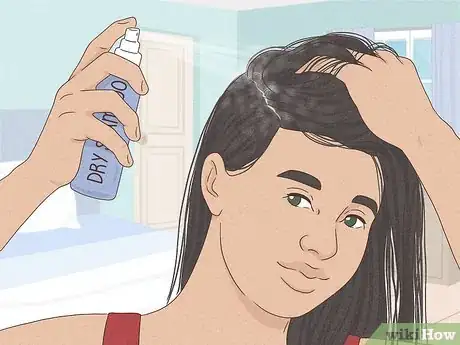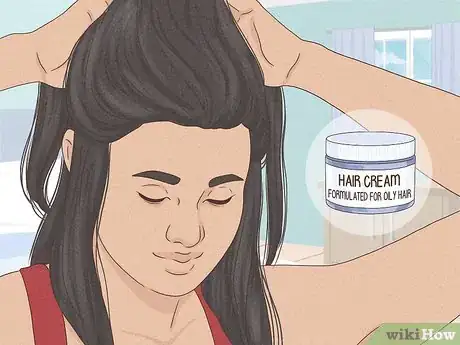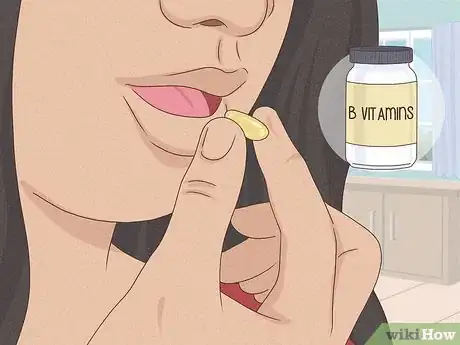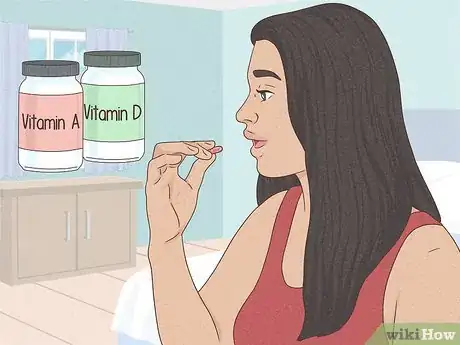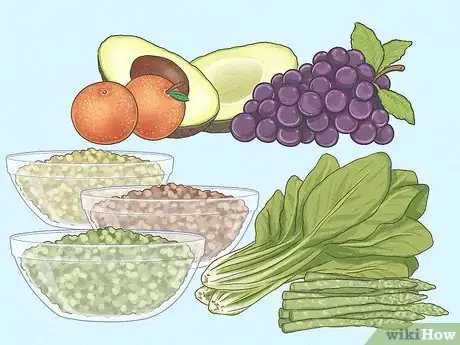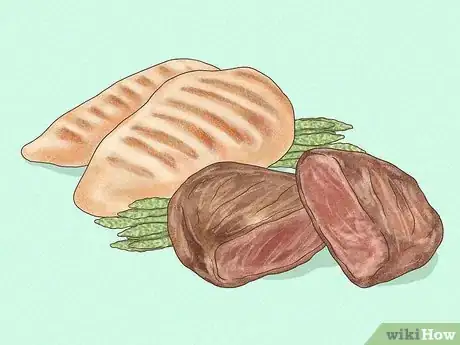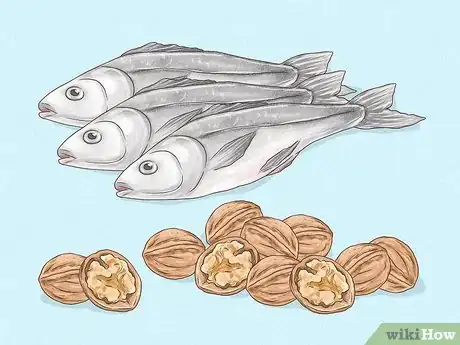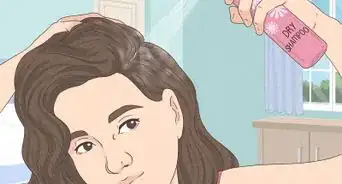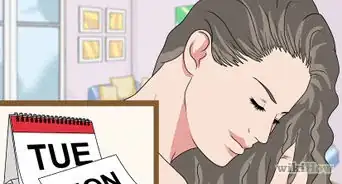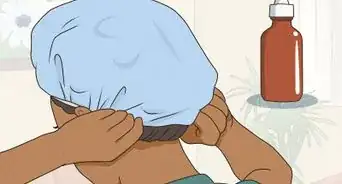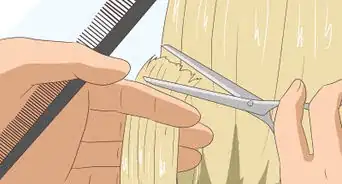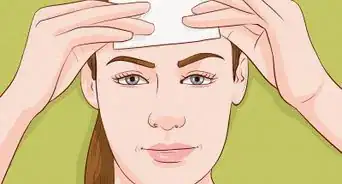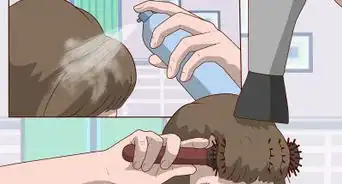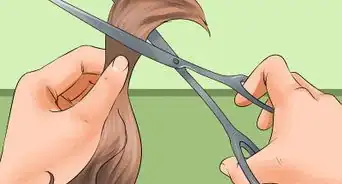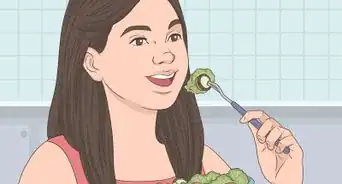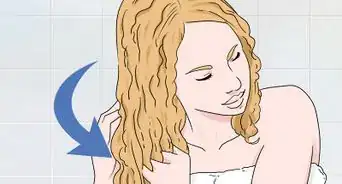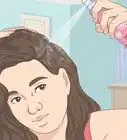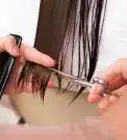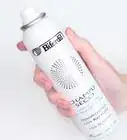This article was co-authored by Nine Morrison. Nine Morrison is the owner of WedLocks Bridal Hair & Makeup, the largest bridal beauty company in Colorado. Her work has been featured in Brides Magazine, The Knot, and by Moroccanoil, and her company replicates this standard across 400+ weddings per year. She has been in the beauty industry for over 10 years, and also travels as a beauty educator and business consultant.
There are 14 references cited in this article, which can be found at the bottom of the page.
This article has been viewed 88,942 times.
We all have natural oil in our hair (known as “sebum”), but some people overproduce this oil, leading to bad hair days galore. On top of this, many people over-style their hair, using greasy mousses, gels, and other products that only worsen the situation. Instead of hiding beneath a hat or pulling your hair into a ponytail at the first sign of greasy strands, you can remedy the problem of excess oil in your hair with fairly simple changes to your hair care regimen or by making changes to your diet.
Steps
Modifying Your Cleansing Regimen
-
1Wash your hair less often. While it may seem counterintuitive, washing your hair can actually cause excess oil production.[1] One reason is because shampoo strips your head of natural oil, and your scalp reacts by producing still more. Also, certain shampoos and conditioners, especially those containing silicone, can leave your hair with more oil or oil-like-substances.[2]
- If you’re used to washing every day, start cutting back slowly and skip only one hair washing per week. Eventually move up to not washing your hair for two to three days at a time.[3]
-
2Use the right shampoo. A gentle cleansing shampoo you will help you to avoid the problem of washing away too much oil. It will also prevent your scalp from producing too much oil. Also, periodically using a shampoo that contains either salicylic acid, selenium sulfide, or ketoconazole will deep cleanse your scalp of hair product build-up, which makes for a healthier scalp and less oily hair.[4]
- Shampoos with tea tree oils can be useful because they absorb oils.[5]
Advertisement -
3Rinse thoroughly. No matter what products you use, you need to make sure that you are rinsing thoroughly. You should rinse for at least 30 seconds, but the longer the better. [6]
-
4Condition the ends only. Keep conditioner away from your scalp, as it can increase oil production. Conditioner is intended to help with the ends of your hair which can become brittle and dry.[7]
- Look for products specially formulated for oily hair and use them sparingly.
-
5Use a home remedy. In addition to the above steps, you can also try a variety of home remedies that make your hair less oily. Many of them use inexpensive ingredients you probably already have on hand or can easily get from the grocery store, like aloe vera, baking soda, baby powder, and tea. The following are a few easy and useful examples.
- Vinegar or Lemon Juice rinse: mix 2 tablespoons (29.6 ml) of white vinegar or the juice of a single lemon with one cup of water. Shampoo your hair, rinse with this mixture, then rinse with tepid water.
- Beer rinse: alcohol is a drying agent, so try mixing a 1/2 cup of beer with 2 cups of water and rinsing your hair with the mixture after shampooing. Be sure to rinse the mix out of your hair thoroughly afterward so you don’t smell like a bar!
- Oatmeal remedy: prepare oatmeal and allow it to cool, then apply it to your scalp and allow it to sit for 10–15 min. Follow with your usual hair care regimen.
Altering Your Styling Regimen
-
1Keep heat away from your head. Heat stimulates oil production, so avoid blow drying.[8] It’s also a good idea to avoid flat irons, curling irons, and hot rollers if serious oiliness is a concern.
-
2Touch your hair less. Running your hands through your hair and otherwise playing with your hair spreads oil from the scalp to the rest of your hair. It may also stimulates oil production at the roots.[9]
- Touching your hair is also problematic because it transfers oils from your hands (from things such as lotion or anything you've eaten) to your hair.
- The same goes for brushing: every time you drag the brush down your head, you’re pulling oil from the roots through the rest of your locks. Obviously you need to brush when you’ve got tangles or pesky fly-aways, but try to resist those 100 strokes a day.
-
3Spray on dry shampoo. These products help to get rid of oiliness at the roots, and they can increase volume.[10] They’re a great option for non-shampoo days.
- Dry shampoo is great for occasional hair help, but you shouldn’t use it every day. It can block hair follicles and make it difficult for the sweat glands on your head to properly do their job.[11]
- Cornstarch, cornmeal, and blotting papers work similarly to dry shampoo, soaking up excess oil in between washes.
-
4Avoid oil-based products. Styling products with silicone or a high concentration of oil can make your hair look greasy, so read ingredient labels carefully and choose alternate stylers.[12]
Changing Your Diet
-
1Get more B2 and B6. These vitamins help the body control sebum production. [13]
- Sunflower seeds are a great source of both vitamin B2 and B6. Other foods that are high in B6 include fish, poultry, red meat, and beans.[14] .
- If you’re not getting enough B vitamins from food, you can take an over-the-counter supplement, available at drug and grocery stores.
-
2Supplement with Vitamins A and D. Like the B vitamins, these help limit sebum production.
- To make sure you don’t overdo (or under-do) the amount, it’s important to check with your doctor before supplementing with Vit A and D (or before beginning a supplementation regimen).[15]
-
3
-
4
-
5Eat omega-3 fatty acids. These are great for hair health. Fish and walnuts are two good sources.[20]
References
- ↑ Nine Morrison. Beauty Consultant. Expert Interview. 3 September 2018.
- ↑ http://womenshair.about.com/od/problemhairadvice/fl/How-to-Prevent-and-Manage-Greasy-Oily-Hair.htm
- ↑ http://womenshair.about.com/od/problemhairadvice/fl/How-to-Prevent-and-Manage-Greasy-Oily-Hair.htm
- ↑ http://www.stylelist.com/read/how-to-prevent-oily-hair/
- ↑ http://www.mnn.com/lifestyle/natural-beauty-fashion/stories/home-remedies-for-oily-hair
- ↑ http://womenshair.about.com/od/problemhairadvice/fl/How-to-Prevent-and-Manage-Greasy-Oily-Hair.htm
- ↑ http://womenshair.about.com/od/problemhairadvice/fl/How-to-Prevent-and-Manage-Greasy-Oily-Hair.htm
- ↑ http://womenshair.about.com/od/problemhairadvice/fl/How-to-Prevent-and-Manage-Greasy-Oily-Hair.htm
- ↑ http://beautyhigh.com/easy-tricks-to-prevent-oily-hair/
- ↑ http://www.dailymakeover.com/trends/hair/how-to-prevent-oily-hair/
- ↑ http://www.sofeminine.co.uk/hair/slick-to-sleek-how-to-take-care-of-greasy-hair-s563439.html
- ↑ http://www.sofeminine.co.uk/hair/slick-to-sleek-how-to-take-care-of-greasy-hair-s563439.html
- ↑ http://healwithfood.org/greasyhair/diet.php
- ↑ http://healwithfood.org/greasyhair/foods.php
- ↑ http://www.dailymakeover.com/trends/hair/how-to-prevent-oily-hair/
- ↑ http://healwithfood.org/greasyhair/diet.php
- ↑ http://www.healwithfood.org/greasyhair/diet.php
- ↑ http://healwithfood.org/greasyhair/diet.php
- ↑ http://healwithfood.org/greasyhair/foods.php
- ↑ http://www.mnn.com/lifestyle/natural-beauty-fashion/stories/home-remedies-for-oily-hair
- ↑ http://womenshair.about.com/od/problemhairadvice/fl/How-to-Prevent-and-Manage-Greasy-Oily-Hair.htm
- ↑ http://www.stylelist.com/read/how-to-prevent-oily-hair/
